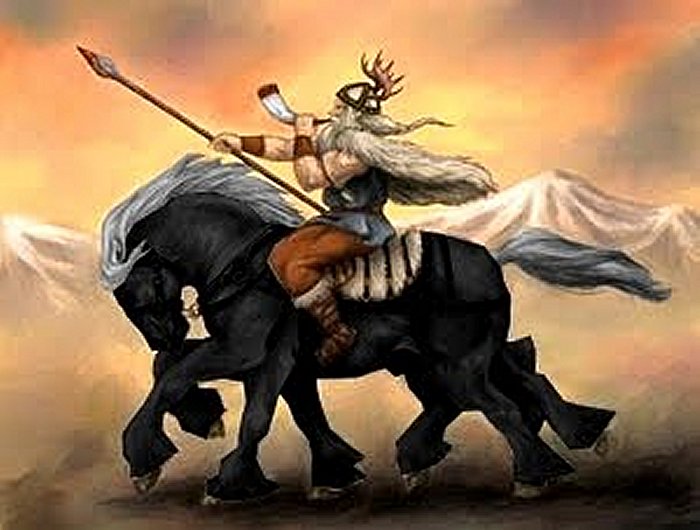

Hrungnir becomes drunk and begins threatening the Asgardians. Feeling he must offer hospitality, he offers Hrungnir a drink, which the giant quickly drains and then calls for more. The Asgardians have no interest in allowing a jötunn inside their walls, but Gullfaxi is so swift that he is right on Sleipnir’s tail and Odin wins by only a hairsbreadth. Odin challenges Hrungnir to a race, and the two set off galloping on their horses toward Asgard. Thor gives Magni Gullfaxi so that now the two greatest horses in the Nine Realms both reside in Asgard. Loki-as-mare, meanwhile, has been finally brought to ground by Svadilfari and impregnated, later giving birth to Sleipnir. They call on Thor to take care of this problem for them, and he appears, smashes the builder’s skull with his hammer, and that ends the difficulty the gods’ faced of the builder perhaps objecting to non-payment. The gods discover that the builder is a jötunn – a denizen of the realm of Jotunheim, land of the frost giants – who are enemies (or at least on uneasy terms) with the gods of Asgard. The builder runs after Svadilfari, chasing him all night, and so the wall is not completed by the deadline. The stallion is instantly attracted to the mare and runs toward her, but Loki-as-mare bolts away into the woods. Loki transforms himself into a beautiful mare and, that night, trots out to where Svadilfari is moving stones.

They tell him that he must fix this or face the worst death they can devise for him. The gods are not interested in paying what he asked and turn on Loki as the one responsible for the agreement. With his horse’s help, the builder has almost completed the walls days before the deadline. It quickly becomes apparent to them that Svadilfari is no ordinary horse as he can move stones from great distances faster than any man could. The eight-legged horse as a shamanic symbol of transformation, however, predates Sleipnir’s name (at least in writing) as Gotland rune stones feature the image of Odin on the eight-legged horse arriving in the afterlife as early as the 8th century. 1179-1241) for the Prose Edda, a unified narrative of Norse myths written in the 13th century. Sleipnir is first mentioned by name in 10th-century Eddic poetry which was among the sources used by the Icelandic historian and mythographer Snorri Sturluson (l. Although there are no stories of Sleipnir predicting the future overtly, he is thought to be quite intuitive, knowing the fastest way to reach a destination to minimize risks to his rider. The divination took the form of harnessing a horse, or horses, to a chariot or wagon and then observing the path they took, usually between spears or other projectiles set on the ground in front of them. In the first century AD, the sacred horses of the Germans were held to understand the will of the gods more clearly than their priests could do, according to Tacitus, so that they were used for divination. Like Freyr’s boar, Odin’s horse traveled swiftly though the sky and down into the realm of death. A horse could carry a departed hero to the realm of the dead and is shown doing this on many of the memorial stones set up in Gotland in the Viking Age. The horse was an animal which could be associated with the journeying sun and it was an important religious symbol in the North from the Bronze Age onwards.

The völva was highly respected, but it was recognized that horses were closer to the gods and could understand them better than any völva. There was no clergy in Norse religious practice, but there was the figure of the völva (seeress), a woman who received messages from the gods, could predict the future, and presided over community rituals. In Scandinavian culture, the stallion replaced the bull as the symbol of virility and power, but horses generally were understood as possessing supernatural abilities that placed them in communion with the gods and spirits. Sleipnir is then thought to carry Odin to the afterlife in keeping with the traditional understanding of the horse a liminal being in Norse mythology. In the final battle between the forces of chaos that include Loki and Sleipnir’s half-siblings Fenrir, Jörmungandr, and Hel – among others – on the side of chaos, most of the Norse gods are killed, including Odin and his faithful horse. Sleipnir’s final ride is to carry Odin to the battlefield of Vigrid at Ragnarök, the Twilight of the Gods.


 0 kommentar(er)
0 kommentar(er)
